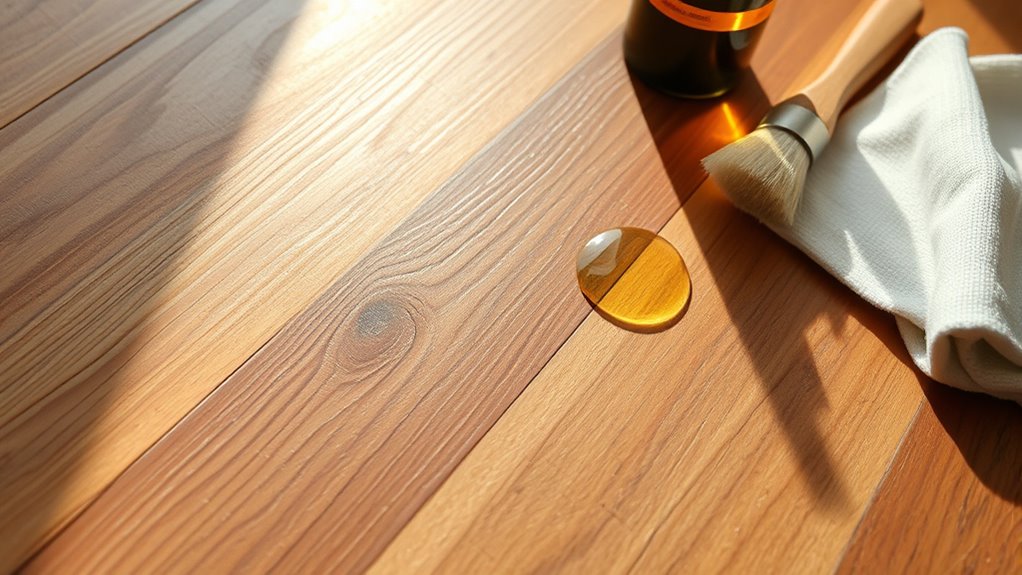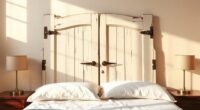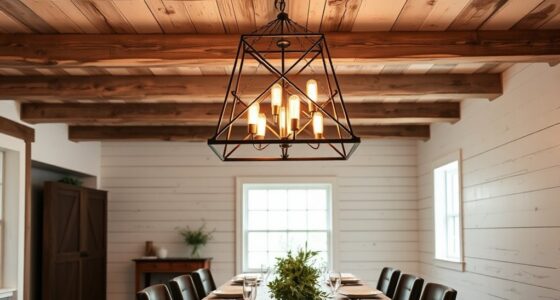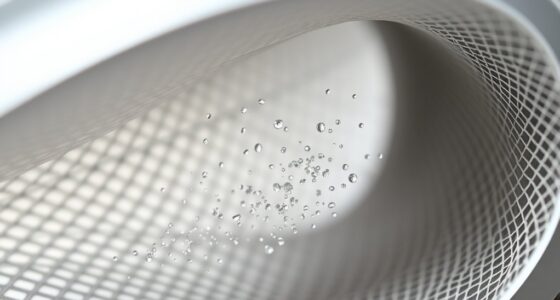To refresh your old wood floors, try using a Magic Eraser for stubborn scuffs, fill cracks and squeaks with baby powder or cork pads, and tackle white water stains with household items like baking soda and heat. You can also restore black marks with walnut or canola oil mixtures, protect surfaces with felt or cork pads, clean safely using vinegar and water, and revive the shine with gentle polishing and natural fillers. Keep going, and you’ll discover more simple secrets to restore your floors effectively.
Key Takeaways
- Use a Magic Eraser for black scuff marks and a baking soda paste for white water stains.
- Fill cracks with baby powder to reduce squeaks and prevent further damage.
- Attach cork or felt pads to furniture legs to protect old wood floors from scratches.
- Clean with a diluted vinegar and water solution, avoiding excess moisture to prevent warping.
- Conceal black marks naturally with crushed nuts and canola oil or use natural fillers like crushed shells.
Use a Magic Eraser to Remove Stubborn Floor Scuffs

If you’ve got stubborn black scuff marks on your wood floors, a Magic Eraser can be a game-changer. This tool effectively lifts scuffs without damaging the finish, making those unsightly marks disappear. Start by dampening the Magic Eraser slightly to prevent excessive abrasion. Gently rub it over the scuffs using light pressure, working in small circular motions. For tougher stains, apply a little more pressure but stay careful not to scratch the wood surface. Once the scuffs are gone, wipe the area with a clean, damp cloth to remove any residue and restore the floor’s natural look. Remember, avoid using the Magic Eraser on glossy or delicate finishes to prevent dulling or scratching. Regularly inspecting your floor and understanding the impact of regular vacuuming on carpet longevity can help prevent dirt buildup that contributes to surface marks. Being aware of proper wood floor maintenance techniques can also extend the life of your flooring. Additionally, using appropriate cleaning tools ensures your floors stay protected from damage. This simple hack keeps your wood floors looking fresh and spotless.
Fill Cracks and Squeaks With Baby Powder or Cork Pads

To silence floorboard squeaks and fill cracks, try dusting baby powder into the gaps using a paintbrush. Baby powder absorbs moisture and debris, helping to fill cracks and reduce squeaks. Once applied, sweep away any excess to keep your floor looking tidy and prevent buildup. For stubborn creaks, gently tap the floorboards to help the powder settle deeper into the cracks. Reapplying baby powder periodically in high-traffic areas ensures squeaks stay at bay over time. Additionally, understanding the contrast ratio of your flooring can help you assess the visual impact of repairs and refinements. Recognizing patterns of behavior in your flooring maintenance can help you develop a regular upkeep routine that minimizes future issues. Incorporating floating on water techniques like using moisture-absorbing powders can also help mitigate underlying issues that cause creaking. Monitoring moisture levels in your wood floors can further prevent swelling and contraction that lead to squeaks over time. Moreover, staying informed about AI in Education advancements can inspire innovative approaches to home maintenance and organization.
Tackle White Water Stains With Household Items and Heat
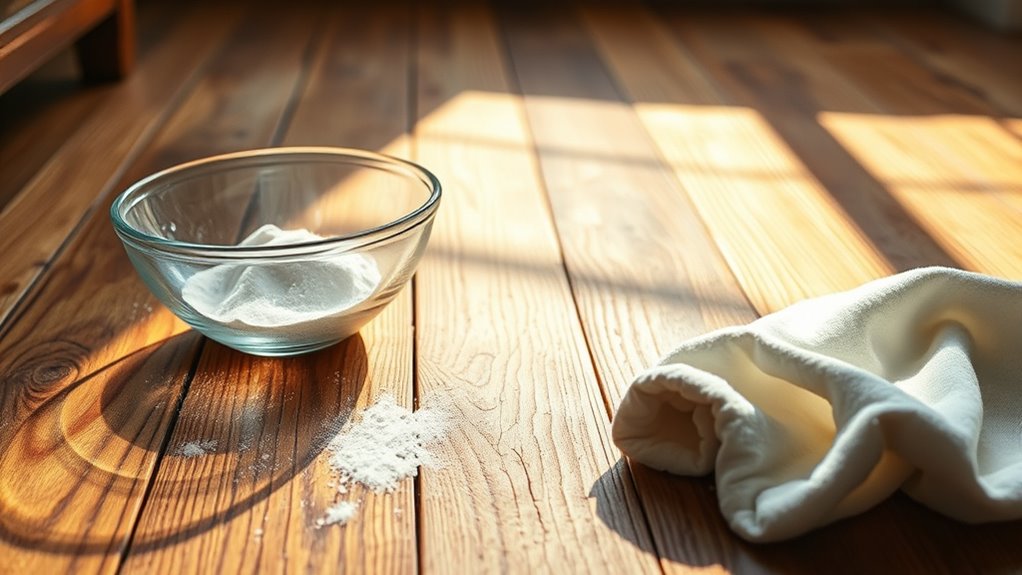
White water stains on wood surfaces can often be faded or removed using simple household items combined with gentle heat. First, apply a paste of baking soda and water directly to the white water stain, then leave it for 24 hours before wiping it clean. This helps lift the stain naturally. You can also use a low-heat hairdryer directed at the water mark to gently evaporate moisture and reduce discoloration. Placing a clean, damp cloth over the stain and applying a warm iron on low heat for a few seconds can draw out the moisture. If the stain persists, lightly sand the affected area with fine-grit sandpaper and restore the finish with matching wood stain. These household items and heat techniques make tackling white water stains straightforward and effective. Additionally, understanding AI-driven personalization in e-learning can help develop more efficient cleaning tutorials tailored to individual learning needs. Proper preventive measures, such as using coasters and tablecloths, can help avoid future stains and damage. Incorporating professional cleaning tips can further preserve the beauty of your old wood floors over time. Regular maintenance, including proper cleaning techniques, and being aware of credit card insights can also assist in budgeting for professional repairs or replacements when necessary.
Restore Black Marks With Walnut or Canola Oil Mixtures
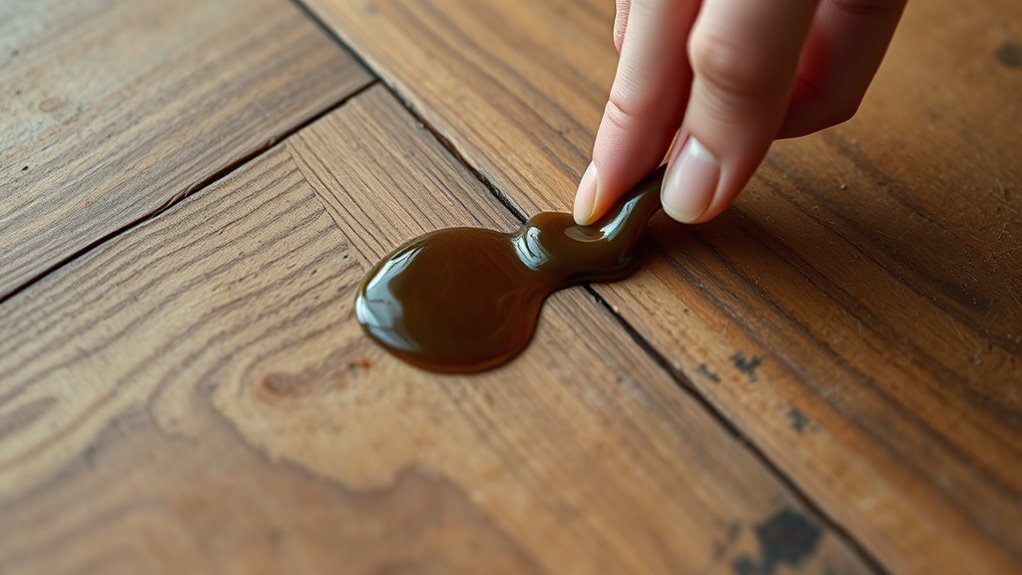
Looking for an easy way to hide black marks on your wood floors? Try using walnut or canola oil mixtures. The natural oils and pigments in nuts can help conceal black marks on old wood floors by penetrating the surface and lightening dark stains over time. Simply rub the meat of a walnut, pecan, or almond into the marks or mix crushed nuts with canola oil to create a homemade remedy. Gently buff this mixture into the black marks with a soft cloth to enhance the appearance without harsh chemicals. Regular application restores moisture and brightness to aged wood, making dark stains less noticeable. Proper application techniques ensure the best results when using nut-based oil blends. With consistent use, walnut or nut-based oil blends can gradually diminish black marks, helping your floors look refreshed and well-maintained.
Protect Floors From Furniture Scratches With Cork or Felt Pads
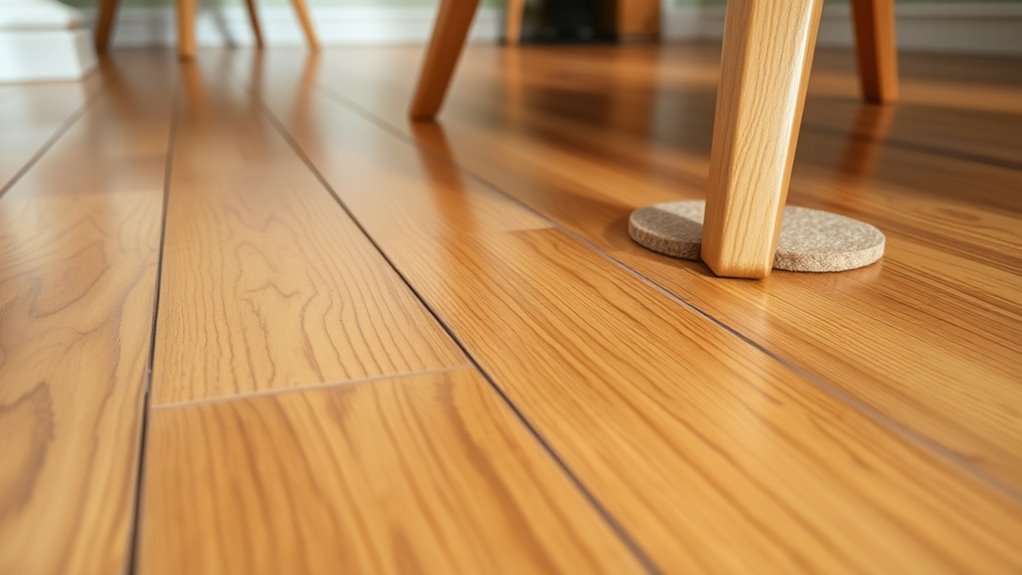
Adding cork or felt pads to your furniture legs is one of the simplest ways to safeguard your old wood floors from scratches. These furniture pads create a soft barrier that reduces friction and prevents damage. Cutting wine corks into thin pads and gluing them to furniture feet is an inexpensive, effective solution. Regularly inspecting and replacing worn or compressed pads guarantees continuous protection. Using pads on all furniture—especially heavy or frequently moved pieces—minimizes deep gouges and surface scratches over time. Properly attached felt or cork pads also help lessen noise and creaking caused by furniture movement. Incorporating floor protection techniques into your routine can further extend the life of your floors. Additionally, choosing appropriate furniture pads ensures compatibility with different furniture types and floor finishes, providing optimal protection. Being mindful of proper installation methods ensures that the pads stay securely attached and perform effectively over time. For added durability, consider selecting pads made from materials specifically designed for wood floor protection.
Safely Clean Unsealed or Old Floors With Vinegar and Water
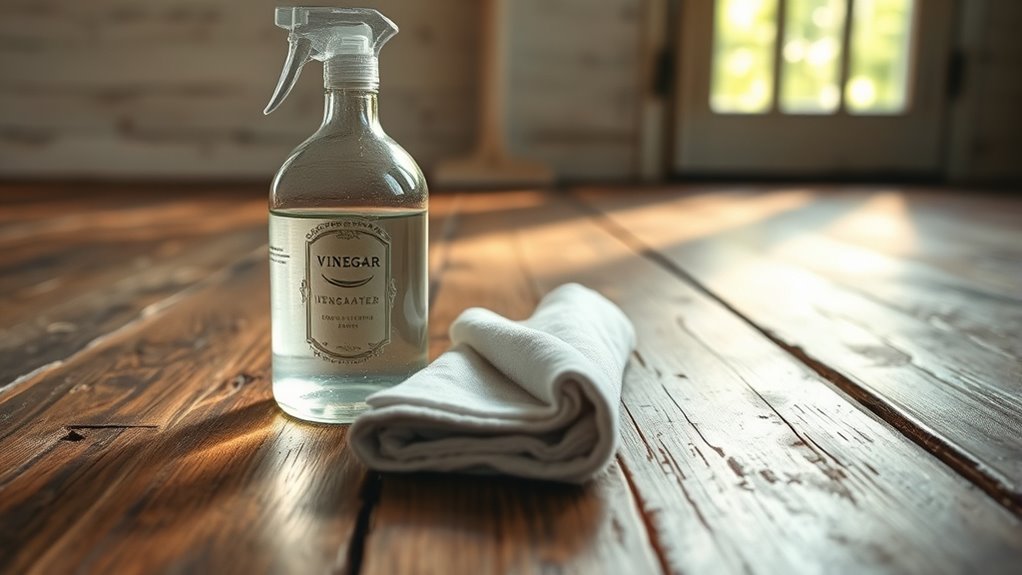
Using a mixture of equal parts vinegar and water provides a gentle way to clean unsealed or old floors without risking damage. Be sure to dampen your cloth or mop lightly to avoid excess moisture that can cause warping. Regularly wiping with this solution helps keep your floors looking fresh while maintaining their integrity. Incorporating digital literacy programs has helped seniors adopt safe and effective cleaning routines with technology. Additionally, understanding the importance of proper maintenance can prolong the lifespan of your floors and prevent unnecessary repairs. Recognizing the characteristics of old wood floors can help you tailor your cleaning approach to preserve their unique beauty. Staying informed about market research can also guide you in choosing the best cleaning products that are both effective and gentle on aged wood surfaces. Being aware of air quality benefits from using appropriate cleaning methods can further improve your indoor environment and protect your health.
Gentle Cleaning Solutions
For unsealed or old wood floors, a gentle cleaning method involves mixing equal parts white vinegar and warm water to create a safe, residue-free solution. This natural approach is perfect for maintaining old hardwood without causing damage. To enhance the cleaning, consider adding a small amount of olive oil to the mixture, which helps condition the wood and adds a natural shine. When cleaning, use a damp microfiber cloth or mop—avoid excess moisture to prevent warping. Always test the vinegar solution on a hidden area first to ensure it won’t discolor or harm your floor’s finish. After cleaning, wipe with a dry cloth to remove any remaining moisture. This gentler method keeps your old hardwood looking fresh while preserving its integrity.
Minimize Water Usage
To clean unsealed or old wood floors safely, it’s essential to minimize water contact during the process. Use a diluted vinegar solution—about 1/4 to 1/2 cup of white vinegar per 2 cups of warm water—to gently clean without over-saturating the surface. Always wring out your mop or cloth thoroughly to keep water contact minimal, preventing warping or damage. Test the mixture on a small, hidden area first to ensure it won’t harm your floor’s finish. Avoid soaking the floors; instead, opt for damp microfiber cloths or mops that release just enough moisture for effective cleaning. Afterward, quickly wipe with a dry cloth to dry the surface, reducing water exposure and safeguarding the fragile, old wood. These cleaning tips help you deep clean without risking damage.
Regular Maintenance Practices
Maintaining your unsealed or old wood floors requires a careful, regular cleaning routine that preserves their integrity. Using a mixture of ½ cup white vinegar and 2 cups warm water provides a gentle yet effective cleaning solution. Dampen a microfiber cloth or mop with the vinegar-water mix, making sure it’s only slightly moist to avoid excess moisture. Avoid abrasive scrubbers or harsh chemicals, which can scratch or damage delicate surfaces.
To keep your floors in top shape, remember these maintenance tips:
- Rinse and wring out your cloth frequently for residue-free cleaning
- Dry thoroughly with a soft towel or dry mop after cleaning
- Stick to gentle cleaning solutions like vinegar and water
- Regular maintenance prevents dirt buildup and preserves your floors’ beauty
Revive Old Wood With Gentle Polishing and Natural Fillers
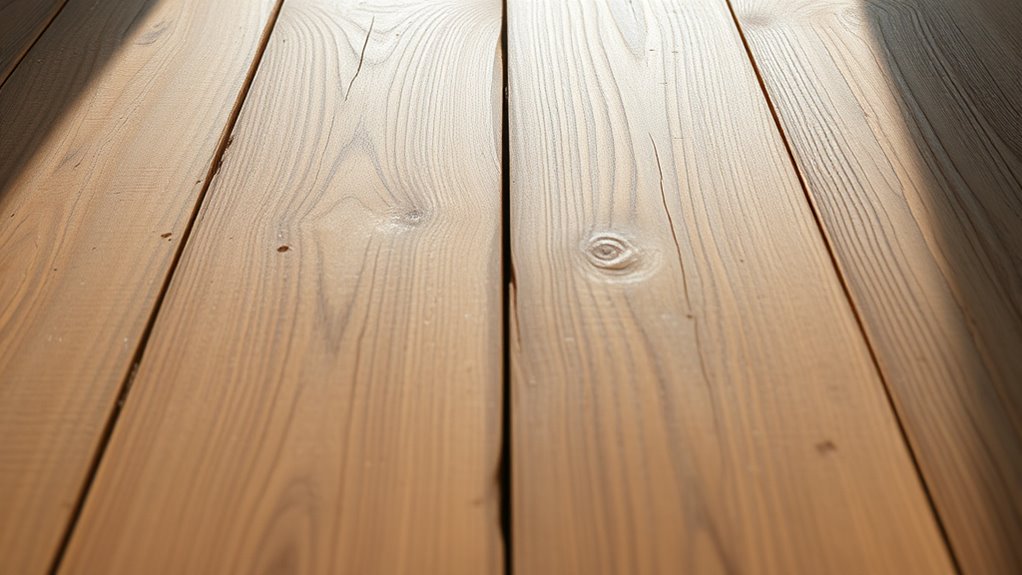
To breathe new life into old wood, start with gentle polishing using products like Weiman Hardwood Polish to restore shine and mask light scratches. Natural fillers like walnut or pecan nuts can help conceal minor imperfections by blending their oils with the surface. For more precise repairs, use matching wood stain markers to touch up small scratches and cracks effectively.
Gentle Polishing Techniques
Gentle polishing techniques can effectively revive old wood floors without causing further damage. To do this, use a microfiber cloth or lamb’s wool pad to evenly apply a gentle wood floor restorer like Rejuvenate. This fills in scratches and boosts shine without harming the finish. For minor imperfections, carefully match and apply a wood stain marker to seamlessly blend repairs. You can also buff in natural fillers, such as crushed walnut shells or almond oil, to temporarily conceal wear and restore a polished look. After polishing, regularly buff the floor with a soft cloth or buffer to distribute natural oils and create a smooth, rejuvenated surface. Remember to work in small sections and follow the grain to prevent streaks and achieve a consistent, refined finish.
Natural Filler Options
Natural fillers are an effective way to revive old wood floors without harsh chemicals. For small cracks and dents, crushed walnut or pecan shells act as gentle, natural fillers that blend seamlessly with aged wood flooring. To smooth out minor cracks and stains, you can apply a paste made from baking soda and water, which fills and evens out uneven areas. Rubbing a small amount of beeswax or carnauba wax onto the surface creates a natural sealant that fills tiny imperfections while protecting the wood. Additionally, a mixture of mineral oil and beeswax serves as a natural filler that conditions the wood and temporarily conceals minor damage. These options keep your wood flooring looking beautiful without introducing harmful substances.
Repairing Surface Scratches
Reviving dull or scratched wood floors can often be achieved with simple polishing techniques and targeted repairs. For surface scratches, use wood stain markers, like Rejuvenate’s set, to precisely fill in damaged areas with matched color. Gently press the marker tip into the scratch, then wipe away excess with a paper towel for natural blending. For lighter scratches, rub oily nuts such as walnuts or pecans into the damaged spot to help blend and fill the scratch naturally. To tackle white water stains, apply a baking soda paste and let it sit for 24 hours before polishing. For dark or black stains, treat with wood bleach and follow up with hydrogen peroxide for lightening. These methods restore your floor’s beauty with minimal effort.
Frequently Asked Questions
How to Clean Really Dirty Old Hardwood Floors?
When your old hardwood floors are really dirty, start by sweeping or dusting with a microfiber duster to remove loose debris. Then, mix warm water, white vinegar, and a touch of olive oil to create a gentle cleaning solution. Dampen a microfiber mop, wring it out well, and clean the surface. For stubborn spots, apply a baking soda paste and scrub gently with a soft brush.
How Do You Make Old Wood Floors Look Good Again?
Think of your old wood floors as a weathered book’s pages—full of stories waiting to shine again. To revive them, gently clean with vinegar and water, like watering a fragile plant. Use oily nuts to fill scratches, blending imperfections. Apply stain markers for deep scars, and buff with a magic eraser or steel wool to restore luster. Finish with a natural wax, bringing your floors back to life, vibrant and full of character.
What Is the Best Hack for Cleaning Hardwood Floors?
The best hack for cleaning hardwood floors is using a microfiber dust mop with a natural solution of vinegar, water, and a few drops of olive oil. You should regularly sweep or dust your floors to prevent dirt buildup, then dampen your mop with this mixture to remove grime and restore shine. Avoid excess water and harsh chemicals, as they can damage the wood. This method keeps your floors clean and beautiful naturally.
How Do You Clean 200 Year Old Wood Floors?
Like a master restorer, you’ll want to treat your 200-year-old wood floors with care. Sweep or dust daily with a microfiber cloth to avoid scratches. Use a diluted vinegar solution on a damp mop for gentle cleaning, and spot test natural mixtures like olive oil and tea on hidden areas. Keep moisture minimal, avoid harsh chemicals, and regularly check for damage to preserve their historic charm.
Conclusion
With these subtle tricks, you can breathe new life into your old wood floors, like dawn’s gentle light awakening a quiet forest. A little care and patience will help your floors shine softly, revealing their timeless beauty beneath the surface. Think of it as tending to a cherished garden—tenderly nurturing each detail, so your space feels warm and inviting once again. Your floors will thank you with their quiet, resilient charm.
